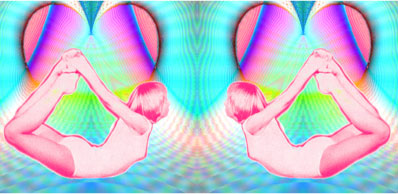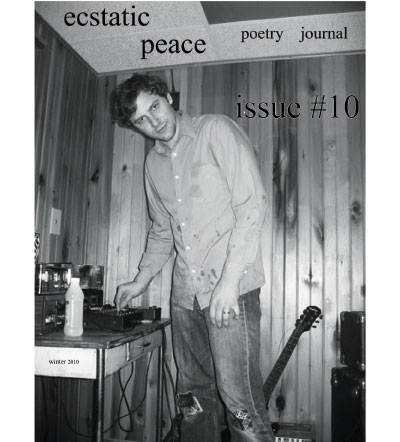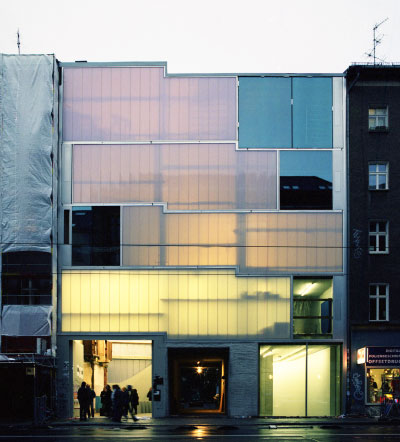

The new building at Brunnenstraße 9 in Berlin’s Mitte district was recently hailed by Artforum Magazine as “a retroactive manifesto of ’90s-era hypercontextualism” and, more simply, “gorgeous”. What their praise didn’t recognize, however, is that this mixed-use space is not just something to look at but a building to listen to; passers-by can plug their headphones into the inconspicuous silver jack embedded in the building’s concrete and literally hear the otherworldly orchestrations of the structure itself.
For the permanent sound installation, titled BUG, American artist Mark Bain embedded seismological sensors at various points of the building. Using a force-feedback system, he then converts the micro-vibrations the sensors pick up into audible sound that can be heard by anyone, at any time of day or night — provided they bring their own headphones. External elements such as wind or rain, as well as the mechanical sounds of the elevator, heating system, and underground metro — in addition to footsteps and muffled voices — are all picked upand mixed into an impromptu, experimental composition. Upon hearing the sound, some listeners dance; others have claimed that it gives them goosebumps.
(more…)
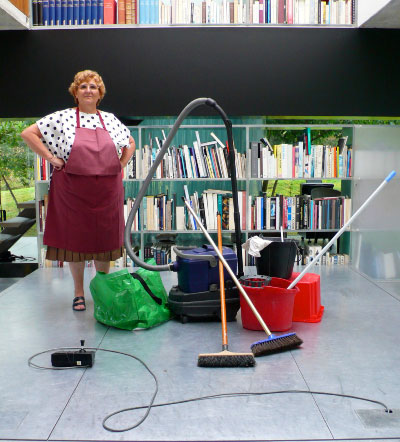
Photography courtesy of Ila Beka and Louise Lemoine

There’s something naughty about Living Architectures, a series of four short films by Ila Beka and Louise Lemoine on view now at Storefront for Art and Architecture, through February 27. Sitting in the dimly lit gallery on worn theater seats and watching them unfurl in continuous loops on the wall feels a bit like visiting a peep show. While each film documents an iconic building by a well-known contemporary architect (Rem Koolhaas’ House in Bordeaux, Frank Gehry’s Guggenheim Museum Bilbao, Richard Meier’s Jubilee Church, and Herzog and de Meuron’s Pomerol Winery), it also skillfully exposes it.
The movies open with images celebrating the formal beauty of these structures before honing in on less pretty physical realities. Footage shows water leaking from the ceiling, floor, and walls of the Bordeaux house. Bird’s-eye interior views of the Bilbao museum reveal poorly resolved geometries and a redundant steel frame. In highlighting these flaws Beka and Lemoine challenge the cultural authority of high architecture, a challenge which seems justified. The buildings they’ve chosen to examine have been conceived ideally, without a deep consideration for practicalities.
The filmmakers also take aim at the discrepancy between the cool, lucid images of these buildings and the prosaic life that unfolds inside of them. A housekeeper struggles carrying a vacuum cleaner up the perilous winding staircase of the Bordeaux house.
(more…)

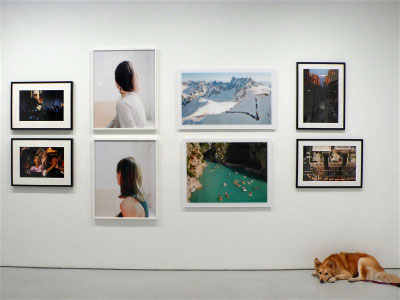
All images courtesy of Danziger Projects unless otherwise noted.


Economically, 2009 could be viewed a debacle. Fortunately gallery owner and photography enthusiast James Danziger does not measure achievement in terms of the Dow. Validating 2009 with The Year in Pictures, now on view at Danziger Projects through February 27, Danziger displays sublime photography from his personal blog. The exhibition, aimed to provide exposure to contemporary artists, allocates three walls to “photographers who would otherwise not be known to New York gallery going audiences” and one for legends in the medium. Resulting from a selection process boiling down to two criteria — quality and originality — the show is a highly satisfying group of images spanning decades, nationalities, and aesthetics.
Featuring work by fifteen photographers — Jowhara AlSaud, Chan Hyo Bae, Thomas Bangsted, Mandy Corrado, Stephen Gill, Joseph Holmes, Alejandra Laviada, Greg Miller, David Schoerner, Patrick Smith, Tommy Ton, Scout Tufankjian, Oliver Warden, Katherine Wolkoff and Tsukasa Yokozawa — representing nine countries — Saudi Arabia, Korea, Denmark, Britain, Mexico, Japan, France, Canada, and the US — The Year in Pictures is a compendium of rich artistic perspectives. United solely by the element of color — a mode of photography almost taken for granted now — works were chosen at Danziger’s discretion to encompass a myriad of subjects and techniques.
(more…)

Best known for his role in Sonic Youth, Thurston Moore has for the last ten years published a poetry journal featuring work by the likes of Gus Van Sant, Kathleen Hanna, Rick Moody, Lenny Bruce (posthumously, of course), and many others. Although primarily a side project — publishing approximately once per year — Moore’s journal has been successful at forging an intimate link between the art, music, and poetry worlds he inhabits. For the next month, famed New York art space White Columns will celebrate the latest issue, #10, with an exhibition and reading and performance series, highlighting some of the journal’s best work and influences.
Ecstatic Peace is inspired by the mimeographed, post-war poetry magazines that proliferated in the 1960s and 70s. Moore began acquiring the mags with friend and co-editor Byron Coley when they hit a wall in record collecting, and the fruits of their obsession are on display here, along with the covers of the earlier issues of Ecstatic Peace.
(more…)
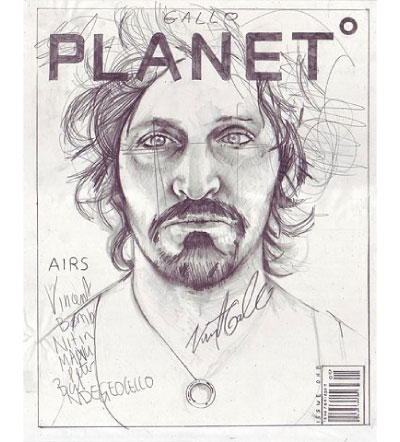

Recently, on the website FFFFOUND, we came across this sketched reinterpretation of our famous Issue One cover which featured Vincent Gallo shrouded by soft white fog — for our AIR issue. Containing a special, and very revealing, “Gallo on Gallo” interview, this issue was a huge hit at the time it came out; even so, we were totally surprised to find this rendering of it posted on FFFFOUND nearly eight years later! Could it have been rendered and posted by Gallo himself? It bears the telltale signs: his autograph and an all-caps GALLO that he adds to old magazines for sale on his website (check out the image via the site on the next page). But then again, it may have simply been copied by a clever artist / interloper who poached it from his merchandise site. You decide. (By the way, if you’ve never been to vgmerchandise.com, Gallo’s own brilliantly narcissistic paradise, you owe yourself the trip. We recommend the Personal Services link for a classic dose of the best and the worst of Vinny Gallo.)
(more…)
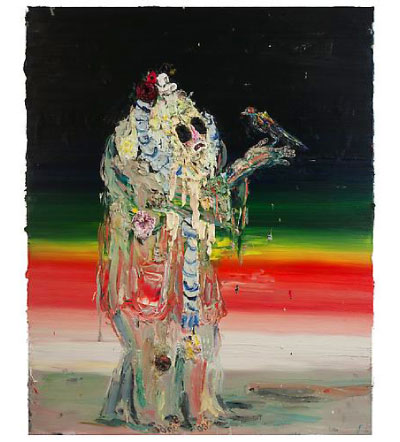
Man With Bird, Allison Schulnik 2009. Images courtesy of Mark Moore Gallery

Allison Schulnik paints rejects. For her second solo exhibit at the Mark Moore Gallery, aptly titled Home for Hobo, the Los Angeles based artist focuses on one of her recurring subjects — the hobo clown — to extend her family of outcasts to include possums, raccoons, and Klaus Kinski. Comprising ten paintings, four sculptures, and a four-minute claymation music video for Grizzly Bear, all dated 2009, Schulnik’s new work embodies the same macabre sensibilities of her previous works, utilizing kitsch subject matter in the traditional formats of portraiture, landscape, and still life. Refreshingly honest, Schulnik’s work is that of excess. Caked in thickly applied impasto, her fantastical characters appear to be melting off the canvas, residing somewhere between their world and ours. Schulnik remarks, “It just felt right for the characters that they should not be so together. They’re falling off of their skeleton, they’re falling off of their own frame.” Simultaneously stunning and unsettling, the characters stare longingly for something that only exists within their fictional frames — beauty, love, refuge, recognition.
Growing up in San Diego, Schulnik describes her childhood as unstructured. “I went around town making art and being bad and being good.” Trained in different forms of dance, Schulnik left the art of moving for the art of the moving picture. Attending the California Institute of the Arts, Schulnik received her BFA in Experimental Animation in 2000. After graduating, Schulnik worked in studio animation for about six years before transitioning entirely to her solo work. A lover of all the archaic forms of art making, Schulnik is a purist at heart.
(more…)

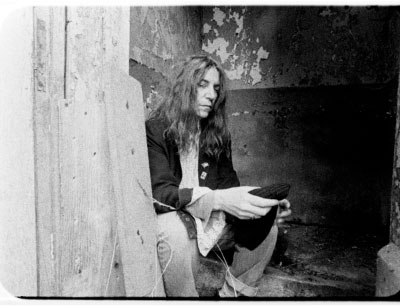


“I always felt somethin’ different stirrin’ in me,” declares a young Patti Smith in Dream of Life, the recent documentary film about her. That young girl’s instincts were right, and in the decades since she spoke those words, Smith has emerged as a radical figure even in the progressive world of rock and roll: a feminine tomboy who led a rock movement while maintaining her fangirl love of the counterculture. The film captures that essence, which is further distilled for Patti Smith and Steven Sebring: Objects of Life, a collaborative show with the filmmaker inspired by the eleven years it took to make the movie. On view at Chelsea’s Robert Miller Gallery, it includes a collection of art, photographs and objects from both artists, and though Sebring is a collaborator, Smith is the star. The show is a paean to her, and to her artistic diversity.
Though Smith is best known as a musician, she is also an accomplished poet and visual artist, and the show leads you through her talents. On view are a number of her ghostly black-and-white photographs, notably as part of her tribute to Arthur Rimbaud, the 19th-century French poet, which is centered on a haunting recreation of his death litter. Smith’s drawings are also a highlight, with their loose, scratchy lines, delicate colors, and emphasis on symbology. Smith dedicates one gallery to her friendship with the photographer Robert Mapplethorpe, a touching installation that alludes to Just Kids, a new memoir by Smith about their shared youth that reminds you Smith is a writer who has always been loud about her influences.
(more…)

Images courtesy of Rizzoli Books

In 1919, a revolutionary school opened in Weimar, Germany. It had a short life — only fourteen years — but it made history. Who among us today has not heard of the Bauhaus or isn’t familiar with its members, from founder Walter Gropius to artists Paul Klee and Wassily Kandinsky, to architect Mies van der Rohe? But there was more to the school than these few world-renowned men — there were, wouldn’t you know it, also many women.
History seems to have washed right over names like Marguerite Friedlaender-Wildenhain, Benita Otte, Gunta Stölzl, and Alma Siedhoff-Buscher, female Bauhaus students who made important contributions in fields such as ceramics, sculpture, weaving, and toy production. But now a new book by Ulrike Müller, simply titled Bauhaus Women and published by Rizzoli to coincide with MoMA’s current Bauhaus exhibition, gives long overdue recognition to “the range of important women — teachers, designers artists — who taught or studied at the Bauhaus” and “carried the idea and works of the Bauhaus forth into the world.”
As it turns out, in its inception, the Bauhaus had vowed equality among all of its students and, despite an inherent sexism among the male masters marked by such fanciful notions that genius and creativity are masculine and that women were only able to see two-dimensionally and should therefore work only with surfaces, Gropius promised that there will be “no difference between the beautiful and the strong sex” (take one guess as to which is which).
(more…)

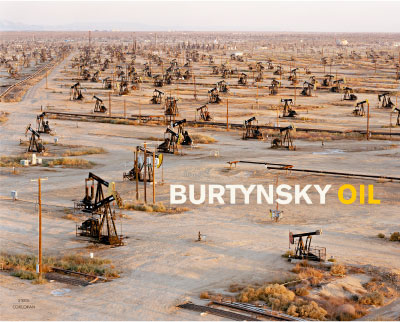
Steidl Books


The world is divided into three types of people: those who are conscious about the environmental damage we inflict on our planet, those who do not care, and those who are inclined to care but need some prodding. Sometimes it takes an artist to put things into perspective, to provide the visceral impact that can shock us into awareness. Edward Burtynsky’s new book, Oil (Steidl, $128), is just the ticket.
Burtynsky has long been fascinated with what he calls “human-altered landscapes,” the vast vestiges of industrial activity. After a while he realized that oil production is the force behind many of these landscapes. Burtynsky began photographing human-made sites that have direct and remote relationships with oil. These include oil fields, refineries, car lots and scrape yards, and highways. The ten-year project resulted in a book containing a hundred panoramic shots from all over the world.
This panoramic view is certainly an eye-opener. Let’s just say that whenever we take an exit from one highway to another, we don’t really think about the intricate anthill infrastructure of the roads. And, of course, some of us would rather not think about the mechanical ugliness of an oil refinery, the unfamiliar, repelling apparatus that we rely on for the modern world to function.
(more…)





 Facebook
Facebook Permalink
Permalink Digg
Digg Reddit
Reddit LinkedIn
LinkedIn StumbleUpon
StumbleUpon Tumblr
Tumblr


